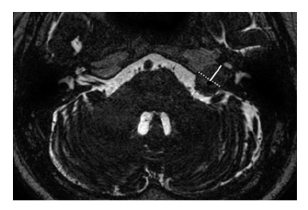Capability of constructive interference in steady state sequence versus postcontrast T1-weighted imaging in cerebellopontine angle and internal auditory canal masses
DOI:
https://doi.org/10.46475/aseanjr.v24i1.205Keywords:
CISS sequence, CPA tumor, IAC mass, Magnetic resonance imaging, Tumor sizeAbstract
Background: The tumor size is one of the main factors in the treatment of cerebellopontine angle (CPA) tumors, and magnetic resonance imaging (MRI) with gadolinium-based contrast agent (GBCA) provides the best evaluation. However, administration of the gadolinium is time consuming and increasing in cost. There is a risk of nephrogenic systemic fibrosis in patients with renal failure and liver or renal transplantation.
Objective: The purpose of this study was to assess the capability of constructive interference in steady state (CISS) sequence in measuring the tumor size of the CPA and internal auditory canal (IAC) masses compared to postcontrast T1-weighted images (T1-WI).
Materials and Methods: The 118 MR studies with both CISS sequence and postcontrast T1-WI of 45 patients with CPA and IAC masses were retrospectively reviewed.
Results: There was no significant difference between CISS and postcontrast T1-WI in measuring size in transverse diameter of the masses (p = 0.051-0.06). The longitudinal diameter measurement revealed a significant difference (p < 0.001) and the measured size on postcontrast T1-WI was slightly larger than the CISS image. The difference in median measurement between two sequences was less than 0.9 mm. and Bland-Altman plots revealed that differences between the two sequences in longitudinal and transverse diameters of the masses were within the limits of agreement. Interobserver agreement showed excellent correlation (r = 0.994-0.999, p < 0.001 by Pearson's product-moment correlation).
Conclusions: The CISS sequence may be sufficient for assessing the size of CPA and IAC masses, which can be used interchangeably with postcontrast T1-weighted image as a contrast-free option, especially in follow-up studies and vulnerable settings of gadolinium administration.
Downloads
Metrics
References
Yilmaz C, Altinors N, Sonmez E, Gulsen S, Caner H. Rare lesions of the cerebellopontine angle. Turk Neurosurg 2010;20:390–7. doi: 10.5137/1019-5149.JTN.2961-10.0.
Kankane VK, Warade AC, Misra BK. Nonvestibular schwannoma tumors in the cerebellopontine angle: A single-surgeon experience. Asian J Neurosurg 2019;14:154-61. doi: 10.4103/ajns.AJNS_335_17.
Springborg JB, Poulsgaard L, Thomsen J. Nonvestibular schwannoma tumors in the cerebellopontine angle: a structured approach and management guidelines. Skull Base 2008;18:217–28. doi: 10.1055/s-2007-1016959.
Singh K, Singh MP, Thukral C, Rao K, Singh K, Singh A. Role of magnetic resonance imaging in evaluation of cerebellopontine angle schwannomas. Indian J Otolaryngol Head Neck Surg 2015;67:21–7. doi: 10.1007/s12070-014-0736-0.
Cavada MN, Lee MF, Jufas NE, Harvey RJ, Patel NP. Intracanalicular vestibular schwannoma: a systematic review and meta-analysis of therapeutics outcomes. Otol Neurotol 2021;42:351-62. doi: 10.1097/MAO.0000000000002979.
Bonneville F, Savatovsky J, Chiras J. Imaging of cerebellopontine angle lesions: an update. Part 1: enhancing extra-axial lesions. Eur Radiol 2007;17:2472–82. doi: 10.1007/s00330-007-0679-x.
Lin EP, Crane BT. The management and imaging of vestibular schwannomas. AJNR Am J Neuroradiol 2017;38:2034-43. doi: 10.3174/ajnr.A5213.
Silk PS, Lane JI, Driscoll CL. Surgical approaches to vestibular schwannomas: what the radiologist needs to know. Radiographics 2009;29:1955–70. doi: 10.1148/rg.297095713.
Hentschel M, Rovers M, Markodimitraki L, Steens S, Kunst H. An international comparison of diagnostic and management strategies for vestibular schwannoma. Eur Arch Otorhinolaryngol 2019;276:71-8. doi: 10.1007/s00405-018-5199-6.
Hentschel MA, Kunst HPM, Rovers MM, Steens SCA. Diagnostic accuracy of high-resolution T2-weighted MRI vs contrast-enhanced T1-weighted MRI to screen for cerebellopontine angle lesions in symptomatic patients. Clin Otolaryngol 2018;43:805-11. doi: 10.1111/coa.13051.
Bakkouri WE, Kania RE, Guichard JP, Lot G, Herman P, Huy PT. Conservative management of 386 cases of unilateral vestibular schwannoma: tumor growth and consequences for treatment. J Neurosurg 2009;110:662–9. doi: 10.3171/2007.5.16836.
Smouha EE, Yoo M, Mohr K, Davis RP. Conservative management of acoustic neuroma: a meta-analysis and proposed treatment algorithm. Laryngoscope 2005;115:450–4. doi: 10.1097/00005537-200503000-00011.
Perez-Rodriguez J, Lai S, Ehst BD, Fine DM, Bluemke DA. Nephrogenic systemic fibrosis: incidence, associations, and effect of risk factor assessment--report of 33 cases. Radiology 2009;250:371–7. doi: 10.1148/radiol.2502080498.
McDonald RJ, McDonald JS, Kallmes DF, Jentoft ME, Murray DL, Thielen KR, et al. Intracranial gadolinium deposition after contrast-enhanced MR imaging. Radiology 2015;275:772–82. doi: 10.1148/radiol.15150025.
Ramalho J, Semelka RC, Ramalho M, Nunes RH, AlObaidy M, Castillo M. Gadolinium-based contrast agent accumulation and toxicity: an update. AJNR Am J Neuroradiol 2016;37:1192–8. doi:10.3174/ajnr.A4615.
Forgues M, Mehta R, Anderson D, Morel C, Miller L, Sevy A, et al. Non-contrast magnetic resonance imaging for monitoring patients with acoustic neuroma. J Laryngol Otol 2018;132:780-5. doi: 10.1017/S0022215118001342.
Bayraktaroǧlu S, Pabuçcu E, Ceylan N, Duman S, Savaş R, Alper H. Evaluation of the necessity of contrast in the follow-up MRI of schwannomas. Diagn Interv Radiol 2011;17:209–15. doi: 10.4261/1305-3825.DIR.3786-10.1.
Abele TA, Besachio DA, Quigley EP, Gurgel RK, Shelton C, Harnsberger HR, et al. Diagnostic accuracy of screening MR imaging using unenhanced axial CISS and coronal T2WI for detection of small internal auditory canal lesions. AJNR Am J Neuroradiol 2014 ;35:2366-70. doi: 10.3174/ajnr.A4041.
Ozgen B, Oguz B, Dolgun A. Diagnostic accuracy of the constructive interference in steady state sequence alone for follow-up imaging of vestibular schwannomas. AJNR Am J Neuroradiol 2009;30:985–91. doi: 10.3174/ajnr.A1472.
Walsh RM, Bath AP, Bance ML, Keller A, Rutka JA. Comparison of two radiologic methods for measuring the size and growth rate of extracanalicular vestibular schwannomas. Am J Otol 2000;21:716–21.
Zou J, Hirvonen T. “Wait and scan” management of patients with vestibular schwannoma and the relevance of non-contrast MRI in the follow-up. J Otol 2017;12:174–84. doi: 10.1016/j.joto.2017.08.002.
Pizzini FB, Sarno A, Galazzo IB, Fiorino F, Aragno AMR, Ciceri E, et al. Usefulness of high resolution T2-weighted images in the evaluation and surveillance of vestibular schwannoma? Is gadolinium needed?. Otol Neurotol 2020;41:e103-10. doi: 10.1097/MAO.0000000000002436.
Lawson McLean AC, McLean AL, Rosahl SK. Evaluating vestibular schwannoma size and volume on magnetic resonance imaging: an inter- and intra- rater agreement study. Clin Neurol Neurosurg 2016;145:68-73. doi: 10.1016/j.clineuro.2016.04.010.

Downloads
Published
How to Cite
Issue
Section
License
Copyright (c) 2023 The ASEAN Journal of Radiology

This work is licensed under a Creative Commons Attribution-NonCommercial-NoDerivatives 4.0 International License.
Disclosure Forms and Copyright Agreements
All authors listed on the manuscript must complete both the electronic copyright agreement. (in the case of acceptance)
















